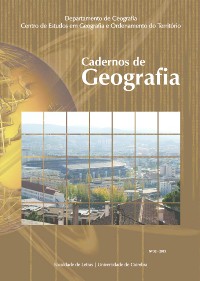Please use this identifier to cite or link to this item:
https://hdl.handle.net/10316.2/30262| Title: | Vulnerabilidade socioambiental de concelhos da Região Centro de Portugal por meio de sistema de informação geográfica | Other Titles: | Vulnérabilité sociale et environnementale des communes de la région du Centre du Portugal par l`utilisation du système d`information géographique Social and environmental vulnerability of municipalities of the Central Region of Portugal by using geographic information system |
Authors: | Freitas, M. Isabel Castreghini Cunha, Lúcio Ramos, Anabela |
Keywords: | Social and environmental vulnerability;Risks;Thematic mapping;SIG;Central Region of Portugal;Vulnérabilité socio-environnementale;Risques;Cartographie thématique;SIG;Région du Centre du Portugal;Vulnerabilidade socioambiental;Riscos;Cartografia temática;SIG;Região Centro de Portugal | Issue Date: | 2013 | Publisher: | Faculdade de Letras da Universidade de Coimbra, Departamento de Geografia | Abstract: | O objetivo principal deste artigo é realizar a análise da vulnerabilidade socioambiental de 17 concelhos que
compõem os distritos de Coimbra, Leiria e Santarém (Região Centro de Portugal). A metodologia adotada para a análise
da vulnerabilidade baseou-se em Análise Fatorial que agregou variáveis sociais e ambientais estudadas, utilizando o
programa de análise estatística SPSS R.18 associado ao programa de Sistema de Informação Geográfica (SIG) ArcGIS 9.3.
Os resultados obtidos indicam como principais fatores de vulnerabilidade socioambiental os relacionados com a falta
de dinamismo económico e demográfico de parte dos concelhos, principalmente os relacionados com o êxodo rural e a
baixa natalidade. O modelo gerado mostrou resultados compatíveis com o conhecimento geográfico que detemos para a
maioria dos concelhos estudados e espera-se que possa vir a servir de base para propostas de políticas públicas relacio-
nadas com as vulnerabilidades aqui cartografadas. L’objectif principal de cette étude est d’effectuer une analyse de la vulnérabilité sociale et environnementale des 17 communes qui comprend les arrondissements municipaux de Coimbra, Leiria et Santarém (Région du Centre du Portugal). La méthodologie adoptée pour l’analyse de vulnérabilité est fondée sur l’analyse factorielle pour l’Analyse en Composantes Principales (ACP), qui a ajutée des aspects sociaux et environnementaux étudiés grâce à l’analyse statistique du programme SPSS R. 18, associé au Système d’Information Géographique (SIG) ArcGIS 9.3. Les résultats indiquent que les facteurs plus importants de vulnérabilité sociale et environnementale sont liés au manque de dyna- misme économique de les municipalités et avec le déficit démographique, principalement relative à l’exode rural et le faible taux de natalité. Le modèle généré a montré résultats en accord avec les connaissances géographiques que nous détenons de la plupart des communes étudiées, et il est prévu de fournir une base pour les politiques publiques liées aux vulnérabilités cartographiées ici. The main aim of this article is to perform an analysis of social and environmental vulnerability of 17 municipali- ties concerning to the districts of Coimbra, Leiria and Santarém (Central Region of Portugal). The methodology adopted for the vulnerability analysis is based on factor analysis which added social and environmental variables analysed using the statistical program for the social sciences, SPSS R. 18, associated with the Geographic Information System (GIS) ArcGIS 9.3. Using as reference the analysis of cartographic documents, as well as Census of the Statistics Portugal, it was possible to map the main variables for social and environmental risks to which populations are exposed and represent them through thematic maps. The results indicated the main social and environmental vulnerability factors are related to the lack of economic dynamism on the part of Municipalities whose main variables were the access to housing credit and number of enterprises. Also, appeared demographic deficits, mainly related to the ageing population and aspects concerning to quality of life, related with the urban areas, whose most influences in the model were the existence of homes with central heating, rural exodus and the low birth rate. The generated model showed results consistent with the geographic knowledge that we hold for municipalities studied and it is expected that could constitute a basis for future proposals for public policies related to vulnerabilities here mapped. |
URI: | https://hdl.handle.net/10316.2/30262 | ISSN: | 0871-1623 | DOI: | 10.14195/0871-1623_32_26 |
| Appears in Collections: | Cadernos de Geografia |
Files in This Item:
| File | Description | Size | Format | |
|---|---|---|---|---|
| cg32_artigo28.pdf | 2.07 MB | Adobe PDF |  |
Items in DSpace are protected by copyright, with all rights reserved, unless otherwise indicated.
